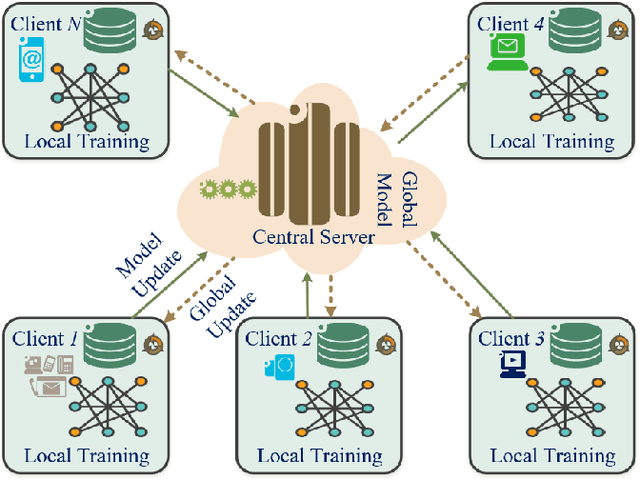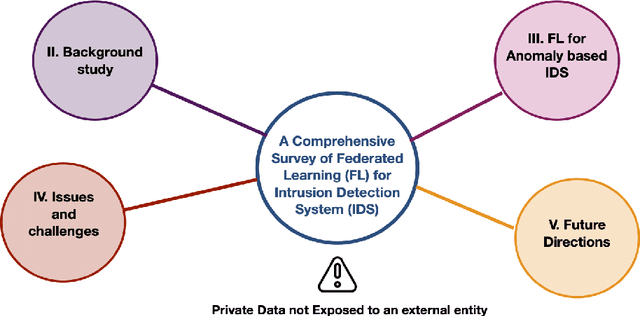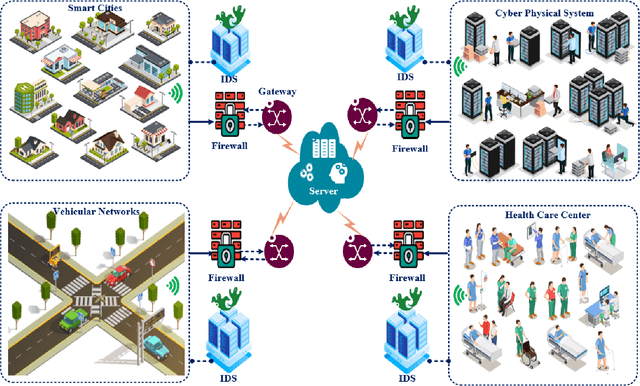Ons Aouedi
A Survey on Intelligent Internet of Things: Applications, Security, Privacy, and Future Directions
Jun 06, 2024Abstract:The rapid advances in the Internet of Things (IoT) have promoted a revolution in communication technology and offered various customer services. Artificial intelligence (AI) techniques have been exploited to facilitate IoT operations and maximize their potential in modern application scenarios. In particular, the convergence of IoT and AI has led to a new networking paradigm called Intelligent IoT (IIoT), which has the potential to significantly transform businesses and industrial domains. This paper presents a comprehensive survey of IIoT by investigating its significant applications in mobile networks, as well as its associated security and privacy issues. Specifically, we explore and discuss the roles of IIoT in a wide range of key application domains, from smart healthcare and smart cities to smart transportation and smart industries. Through such extensive discussions, we investigate important security issues in IIoT networks, where network attacks, confidentiality, integrity, and intrusion are analyzed, along with a discussion of potential countermeasures. Privacy issues in IIoT networks were also surveyed and discussed, including data, location, and model privacy leakage. Finally, we outline several key challenges and highlight potential research directions in this important area.
FLEXIBLE: Forecasting Cellular Traffic by Leveraging Explicit Inductive Graph-Based Learning
May 14, 2024Abstract:From a telecommunication standpoint, the surge in users and services challenges next-generation networks with escalating traffic demands and limited resources. Accurate traffic prediction can offer network operators valuable insights into network conditions and suggest optimal allocation policies. Recently, spatio-temporal forecasting, employing Graph Neural Networks (GNNs), has emerged as a promising method for cellular traffic prediction. However, existing studies, inspired by road traffic forecasting formulations, overlook the dynamic deployment and removal of base stations, requiring the GNN-based forecaster to handle an evolving graph. This work introduces a novel inductive learning scheme and a generalizable GNN-based forecasting model that can process diverse graphs of cellular traffic with one-time training. We also demonstrate that this model can be easily leveraged by transfer learning with minimal effort, making it applicable to different areas. Experimental results show up to 9.8% performance improvement compared to the state-of-the-art, especially in rare-data settings with training data reduced to below 20%.
Federated Learning for Intrusion Detection System: Concepts, Challenges and Future Directions
Jun 16, 2021



Abstract:The rapid development of the Internet and smart devices trigger surge in network traffic making its infrastructure more complex and heterogeneous. The predominated usage of mobile phones, wearable devices and autonomous vehicles are examples of distributed networks which generate huge amount of data each and every day. The computational power of these devices have also seen steady progression which has created the need to transmit information, store data locally and drive network computations towards edge devices. Intrusion detection systems play a significant role in ensuring security and privacy of such devices. Machine Learning and Deep Learning with Intrusion Detection Systems have gained great momentum due to their achievement of high classification accuracy. However the privacy and security aspects potentially gets jeopardised due to the need of storing and communicating data to centralized server. On the contrary, federated learning (FL) fits in appropriately as a privacy-preserving decentralized learning technique that does not transfer data but trains models locally and transfers the parameters to the centralized server. The present paper aims to present an extensive and exhaustive review on the use of FL in intrusion detection system. In order to establish the need for FL, various types of IDS, relevant ML approaches and its associated issues are discussed. The paper presents detailed overview of the implementation of FL in various aspects of anomaly detection. The allied challenges of FL implementations are also identified which provides idea on the scope of future direction of research. The paper finally presents the plausible solutions associated with the identified challenges in FL based intrusion detection system implementation acting as a baseline for prospective research.
 Add to Chrome
Add to Chrome Add to Firefox
Add to Firefox Add to Edge
Add to Edge